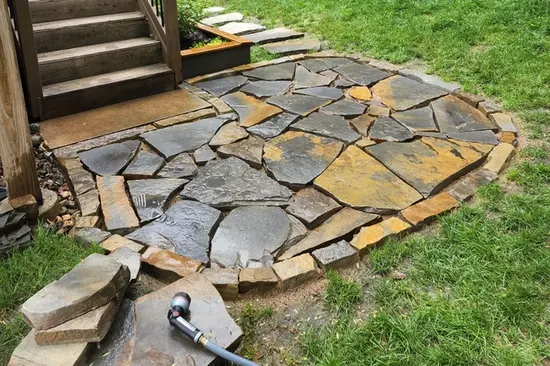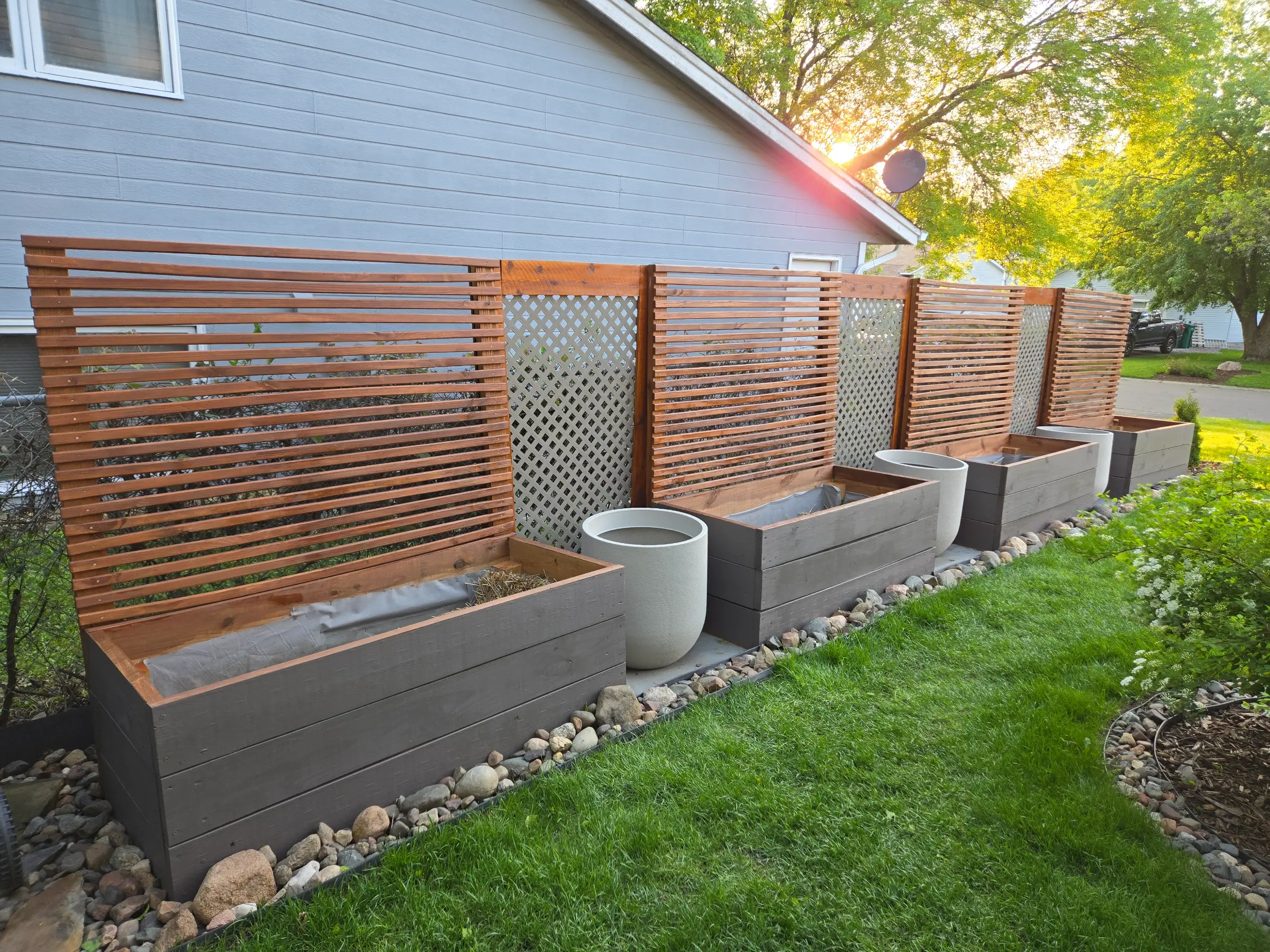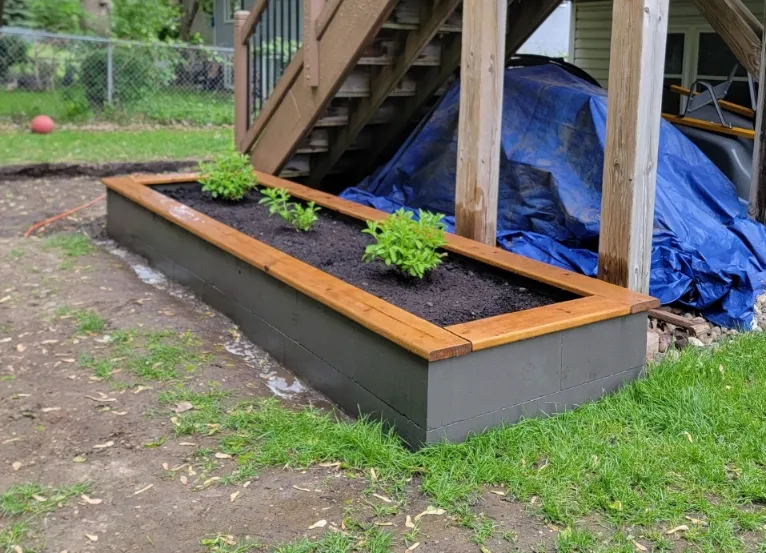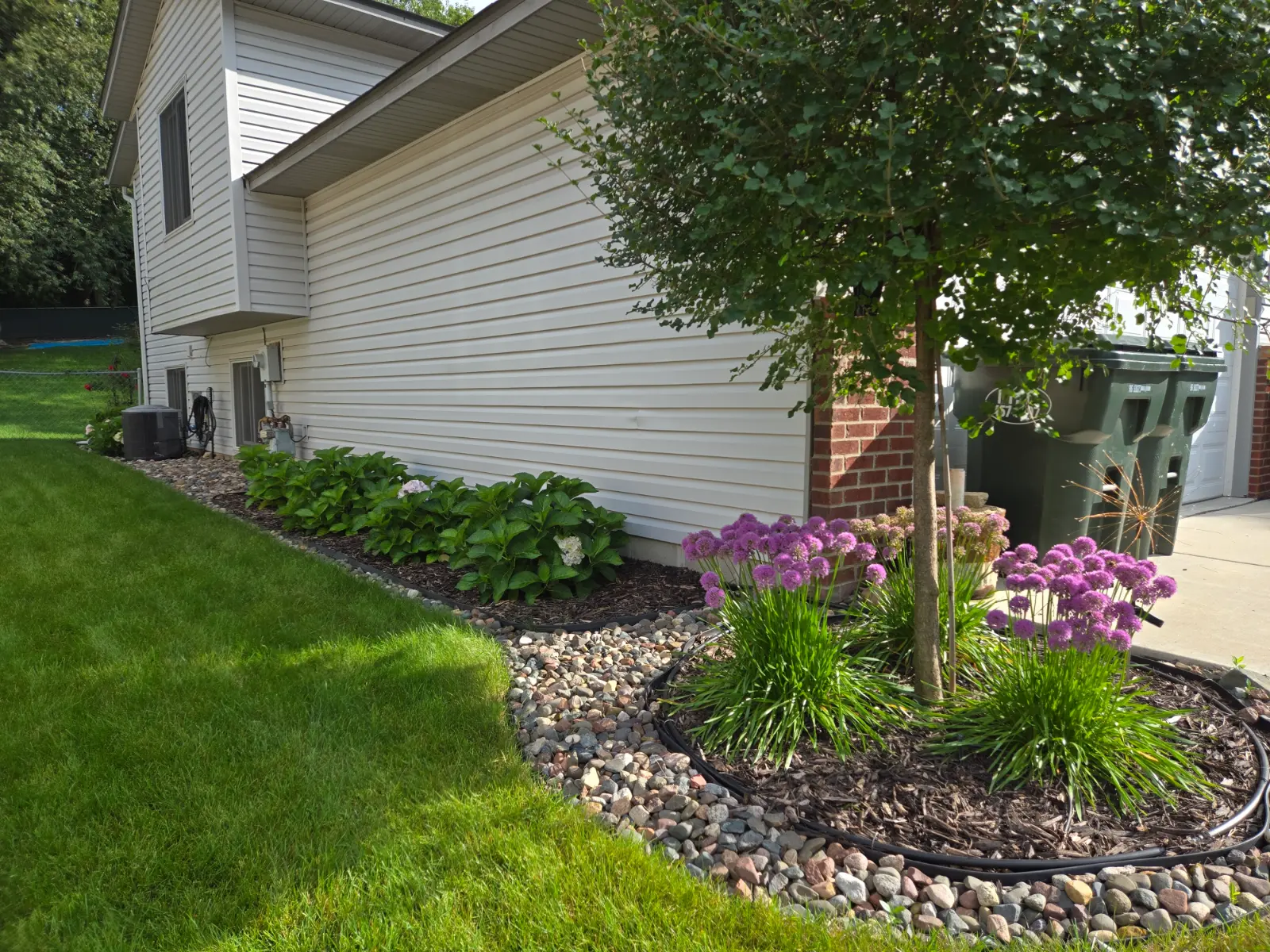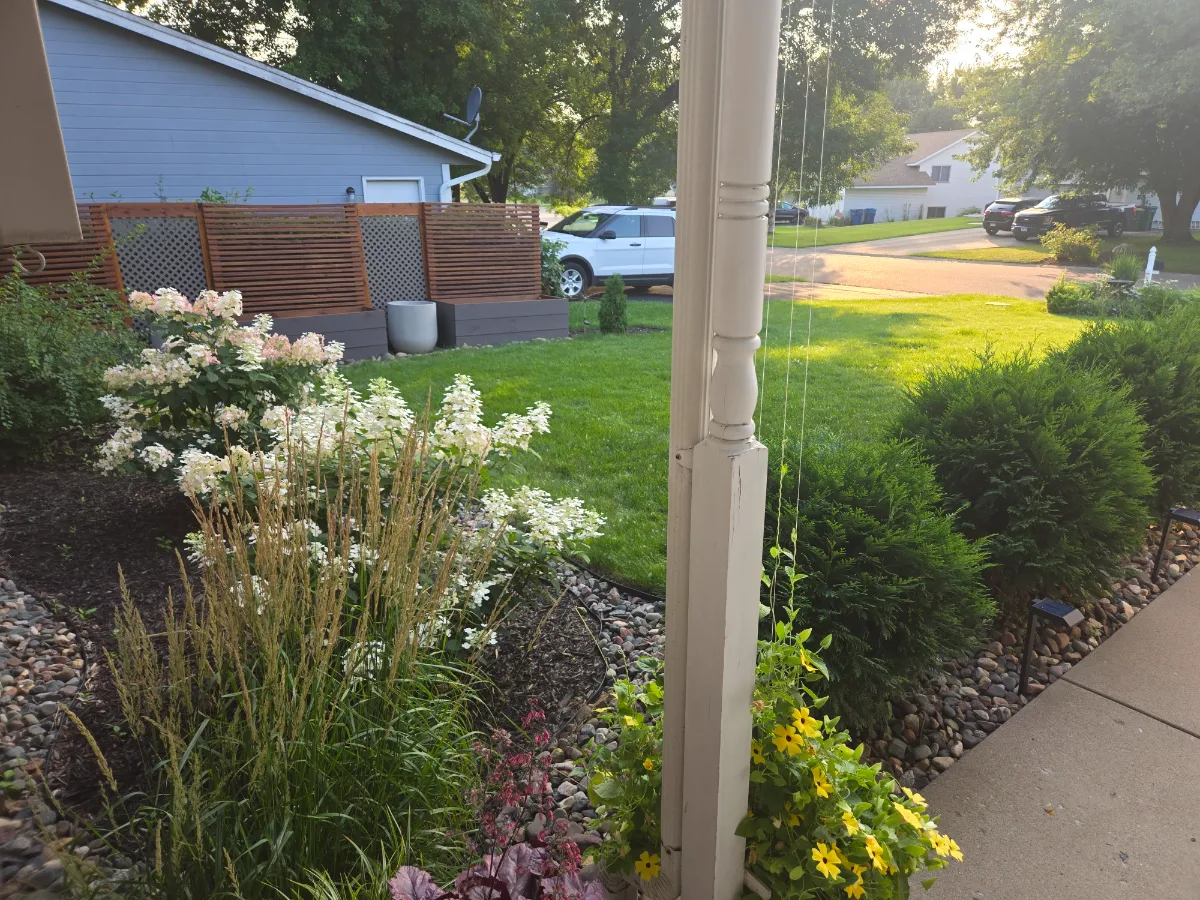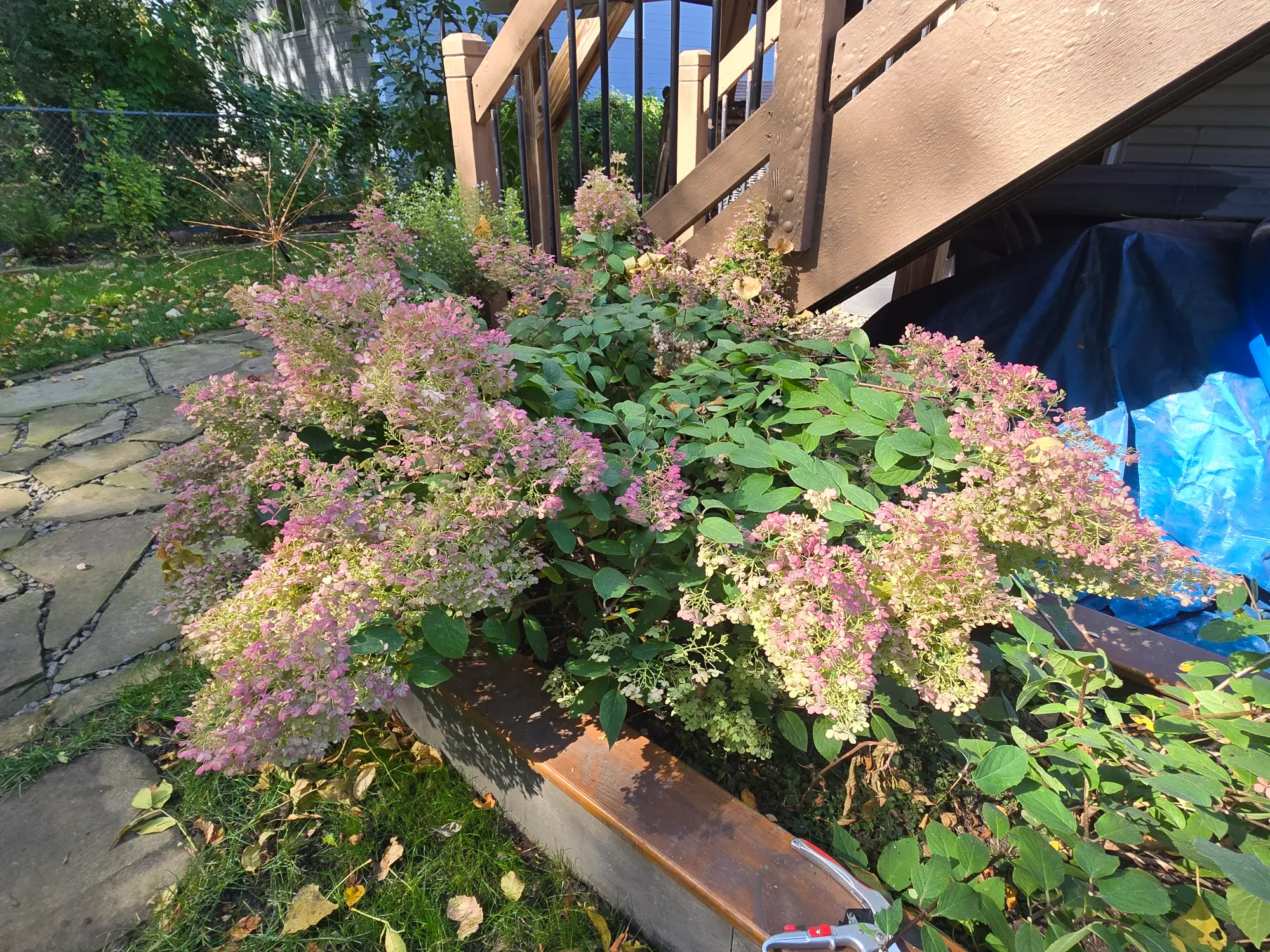Why Plant Hydrangeas In A Raised Bed (And How It Saved My Shrubs)?
I’m sure you are very familiar with the use of raised beds and how they can be ideal for growing your vegetables, but have you ever considered planting shrubs in a raised bed?
I feel that raised beds can serve multiple purposes in your garden. You can take an area of your yard that may seem flat and boring and bring additional character by raising up your gardens and adding height or layers that will be visually appealing when overlooking your lawn. Not only that but it can improve your ability to provide the right growing conditions, or simply give you the option to plant in an area you may have otherwise deemed hopeless due to drainage issues (spoiler alert: this was my issue).
Below are a few reasons why I think planting hydrangeas in a raised bed is a great idea.
Adds Aesthetics To Your Garden
Now I didn’t choose to build beds myself for this reason, but I will say that I’ve enjoyed the look it has brought to our backyard. I built my raised bed out of concrete blocks and painted them a slate blue color to match my garden shed door, and let me tell you that finding a matching color was quite the challenge for me.
I would grab color samples based on memory, but get home to compare to the shed door and would just laugh at how wrong I was. You should have seen me the day I found it though, as I was ecstatic and had to go tell my husband how proud I was for finally finding the right color match.
Here is a picture I had to take just so that I could prove just how close of a match I found when comparing it to our shed door off in the distance. It really is the simple things. 🙂
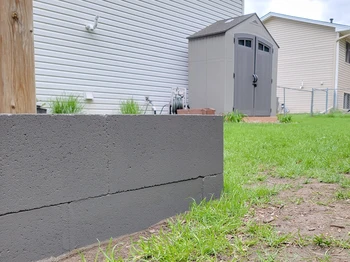
I try not to care too much about something like this since at the time it was just my solution to keep my hydrangeas alive, but a small part of me really just wanted to see if I could do it, and it looks so much nicer because I took the time to focus in on those details. I’ve also chosen to continue this paint color with the other beds I’ve built for my vegetable garden in my front yard, to keep things uniform, as shown below.
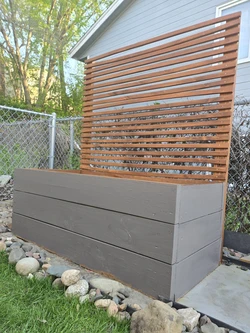
I like the idea of raised beds because there are so many options to choose from, and even though I went with concrete blocks, you could really go with just about anything. Think about building your beds using lumber/wood, bricks, stones/rocks, or even recycled materials like old used tires.
The list could go on I’m sure, but obviously you want to consider your situation and why you are choosing to add raised beds into your landscape, and what sort of look you are going for in your design. Raised beds will allow you to define your space, and how you might want to use it. They can give a clean look as well if you choose to build them that way. Here is how my bed turned out once built and my hydrangeas started to spring to life once planted.
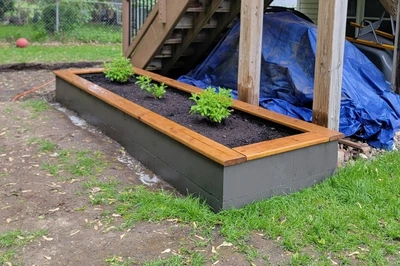
However you choose to incorporate raised beds in your landscape, it will provide you the added character in your garden, and with the added height you will be able to see the layers in your plants even without having to buy a larger sized plant to gain that extra height.
Help Manage Soil Conditions
Another beneficial reason to incorporate raised beds into your landscape is when you might be dealing with soil conditions that are not ideal for the particular plant you want.
I live in Minnesota and we are known to have clay and slightly acidic to neutral pH rated soils (meaning we fall around the 6.0-7.0 pH scale), which honestly works great for many plant varieties. My hydrangeas seem to thrive wherever I plant them around my house, although this too is not a reason I chose to plant them in a raised bed.
However, this is another excellent reason TO plant these shrubs in raised beds because if your area does not have ideal pH levels, perhaps much too alkaline for your plant, you can correct this from the start with a raised garden bed! Add in the right type of soil and amendments from the start, and it will turn the soil into the perfect conditions your hydrangeas will thrive in.
Also, it would be much easier to maintain and likely last longer than planting directly into the ground because you can try to amend your natural soil as best you can, but unless you keep it up there’s a great chance that it will return to its original state eventually as this is where it’s supposed to be.
Improves Drainage Issues
And here we are, the main reason and only reason I chose to plant my hydrangeas in a raised bed. I probably wouldn’t have thought to do this early on in my landscaping journey, but thankfully I had to experience it for myself, and in turn it has brought me more inspiration and confidence to include raised beds in my garden designs.
Before building this bed, I started by landscaping around our deck, and simply planting my hydrangeas directly into the ground. It looked really nice, until it didn’t work for us anymore.
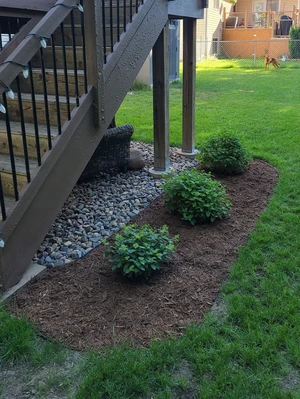
This was truly a trial and error garden experience too, as you will see in the pictures I’ve shared, this was not the first design attempt. I should have known it wouldn’t work from the get go as I was fully aware of our drainage issues during the spring, however we did have a french drain installed so I was hopeful that this would be our final solution to our flooded spring seasons.
Disclosure: Please know there are links shared that may be affiliate links, meaning at no additional cost to you, I could earn a small commission if you click on a link within my post. You can read more about this here.
The image below demonstrates what we were dealing with after winter passed and all of the snow melted.
Note: this was before our french drain was installed.
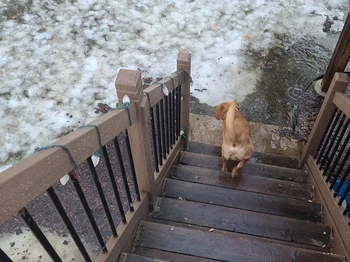
However when you are also working against a steep hill leading down to your house, I feel you are destined to have to deal with some sort of standing water regardless of having a french drain. The snow will melt and in turn that water will flow downhill and concentrate where it starts to level out.
Here is a picture the following season after a heavy rain when I was working on my first garden design. This was one of the original garden projects I was doing when I initially started landscaping around our house, and I think I was digging my holes so deep because I thought it would help with drainage beneath the plant, since the soil in this area was so compact and I didn’t want my newly planted hydrangeas to get waterlogged. I was still learning, and through this experience I’ve taught myself that there are multiple things to consider when landscaping, which I share more of down below.
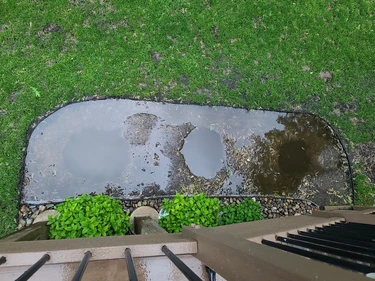
Because we live in Minnesota, and the snow is not going anywhere, we will always find that we are going to have to deal with some sort of standing water, at least once the snow melts or we have days with continuous heavy rain. Through experience, we’ve discovered ways to speed up the drying process. One not so fun way was on a nice sunny day I’d go out with my bucket and scoop up water to then pour into the french drain basins, haha.
This worked, however it took a long time, so I will share a product I found that has been a life saver for us. I highly recommend this water pump if you deal with drainage issues of your own, or to be honest, simply need an easy way to move water from one point to another.
I don’t like to waste water, so I decided to test it on our dog’s kitty pool at the end of a hot summer day. I grabbed our ‘WaterBug’ and tossed it into the pool, hooked up the hose, and directed the water to my plants. This worked so well too, and I didn’t have to just pour the water out into the lawn in one spot where it’d get sloppy, and depending on my dog’s mood that day, it wouldn’t become a target mud spot he’d dart back and forth in, out of excitement, getting his paws all filthy. 🙂
Anyway, back to what may seem like an obvious reason now, but by building a raised bed I was able to lift my garden space above its flood zone and keep my hydrangeas from getting waterlogged.
Do Hydrangeas Grow Well In Raised Beds?
You might be thinking it is not as common to landscape with raised beds, especially when you are planting larger sized shrubs or anything besides vegetables really. The idea behind raised beds is for convenience right? Well yes, but truthfully there are many other reasons as you hopefully learned above, that make the idea seem more appealing now, right?
Hopefully I’ve given you a reason to want to think about using raised beds in your own garden design, but another thought comes to mind, and that is can your hydrangeas even grow well in beds? I’ve shared my reasons down below to hopefully better persuade you, but as shown below, through my own experience, these hydrangeas are thriving in this raised bed.
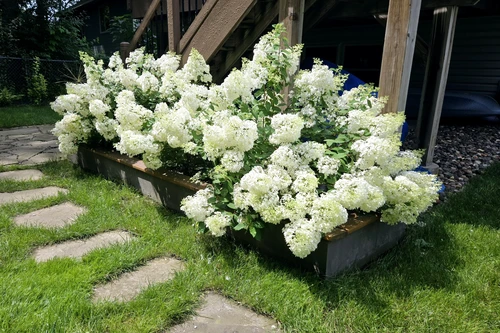
Ideal Growing Conditions
As mentioned previously, hydrangeas can do very well in raised beds because you have the ability to provide them their ideal growing conditions by amending the soil to match their needs.
Managing pH Levels:
Hydrangeas do well when your pH levels are falling closer to being slightly acidic, and if you are living in an area with highly alkaline soils your plant may not receive the appropriate nutrients it needs to perform like it should.
Soils Compaction:
Raised beds will keep the soil from becoming too compacted as well since it remains undisturbed by human (or pet) traffic. Compacted soils can become an issue if you are experiencing heavy rains, and the soil does not absorb the water as easily which will affect the plants ability to pull in water or nutrients when it needs them.
Soil Erosion:
Another thing you may not think about when starting a garden, is having to deal with things like wind or heavy rains which can remove the top layer of your garden’s soil and take the nutrients with it. At least in a raised bed, it has no place to go but remain inside of your planter.
Provides Hydrangeas Added Protection
I included this section in my list because my mind instantly goes back to all of those times my hydrangea’s branches would break off because I happened to find the most fun ball for my dog to play with in the backyard, and he becomes so obsessed as well as fast with it that he pushes it all the way up the hill with his nose and charges back down straight towards my hydrangeas. These were not in the ideal spot for this type of play and I attempted to protect my hydrangea by barricading them with a plastic garden netting as shown below, but I didn’t have the heart to take this toy away from him because it has come in so handy when needing to tire him out.
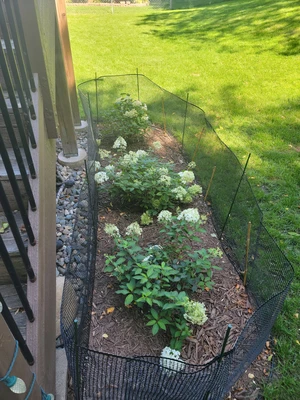
If you are interested at all I’ve linked it here because besides it being tough against my plants at times, it has been enjoyable to watch. Even my neighbor a couple doors down had to come over and ask me where I got it because they enjoyed seeing him play in the backyard and wanted one for their own dog.
Alternatively, raised beds may help keep smaller animals away from your plants since they could be more skeptical to jump into something unfamiliar, or depending on the height of your bed, won’t be able to access them at all.
However, do know that if they are determined, they WILL get into your bed. This is confirmed through experience, as my neighbor next door sent me a picture of a rabbit nest full of baby bunnies, in her raised garden bed last summer, and her beds have to be waist high.
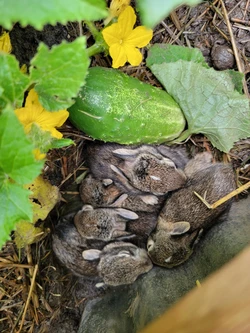
Lastly I think raised beds will add the necessary protection to your hydrangeas or other plants when dealing with lawn maintenance. Think of the maintenance that goes into your lawn care, or perhaps you have a landscaping or lawn service that comes by to spread weed control or use string trimmers. By lifting your plants above ground level, it can also prevent them from receiving unnecessary herbicides or harmed by a string trimmer.
What Should You Know Before Planting Hydrangeas In Raised Beds
I know I’ve shared my reasons above as to why you should consider adding raised beds in your landscape, but there are always other things you should take into consideration before fully committing, so you can give yourself the best chances of success from the start.
Here are a few things I think you should also know before you start building beds of your own.
Consider The Space
It’s important in all situations to consider the space whenever you’re going to be landscaping around your home, and even more so when you are limiting your space with a raised bed.
Some plants may be too large for the bed you place them in, so please always check the mature size beforehand. Hydrangeas are shallow rooted shrubs and I’ve noticed they tend to spread out near the surface, so you can imagine if they reach the outer edge of your bed they may end up becoming rootbound if it would have needed more room to spread.
The hydrangeas you see in my bed are known as Bobo hydrangeas. This dwarf variety is considered to be the smaller compact version of Limelights which you may know can get very large. This is why I think mine have done so well these past few years as their root balls stay fairly compact, and their size shouldn’t get more than 3 feet around.
Think of the root ball as a mirror image of the plant you see above ground. If you know the mature width of the plant you plan to use, this will likely end up the size of its root ball. I think that might also be the reason you want to follow the drip line when fertilizing or watering, so that you are placing the nutrients the plant needs where it’ll be most successful in reaching the active roots.
And it goes without saying, if you are planting more than one plant in your raised bed be sure to space them far enough apart so they will not overcrowd each other. I might have gone a tad bit too close with my own, but I think they are still far enough apart to get adequate air circulation to keep from the leaves forming any fungal diseases.
Provide Adequate Irrigation
The major advantage of planting directly into the ground is that your plants have the best chance of absorbing the natural moisture in the soil. It will not dry out too fast either, so you are having to irrigate a lot less frequently.
Not the case with raised beds. If you choose to plant in raised beds, you will need to know that the soil within the bed walls will dry up much faster, and in turn you will need to remember to water your plants more frequently. Consider the days you get rain too, as this does help delay the frequency of you having to water your own beds thankfully.
You could also consider using mulch, or do what I did and plant Creeping Jenny to shade out the soil and protect the roots from the direct afternoon sun my hydrangeas receive during the day. Just know this is a spreading ground cover and it does grow quickly. I have trimmed it back during the summer to prevent it from entering my lawn, although it is easy to pull up if I don’t get to it in time.
Location
Location is very important to consider as well when planning a garden design using raised beds because unlike simply planting something in the ground and moving it if it doesn’t work out, you are sort of stuck with your decision on where you build this raised bed.
I know it can be done of course, with effort, but chances of you relocating a raised bed once it’s been built is slim. So be sure to clock the amount of sun you are receiving in the location you plan to add raised beds.
It is always wise to consider what your beds are made out of as well, or what the outer color of the beds will be, as the sun will be absorbed into darker colors better than lighter, as well as certain materials will take in more heat. I did not build my beds very tall, so the concrete blocks, which I painted a dark color, do not see a lot of the sun during the day. Besides, the Creeping Jenny does a good job at spilling over the edges anyway…
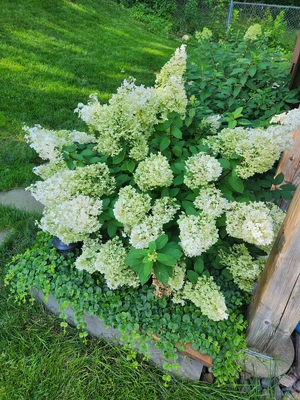
Should You Plant Hydrangeas In A Raised Bed?
Now that you have read from my point of view on why I think landscaping with raised beds can certainly work, as well as what things you should consider before moving forward with a project like this of your own, it’s time to think if this is something you should do in your own garden plans.
I’ve listed a couple recap questions to ask yourself, that might help with your decision.
How Are Your Drainage Conditions?
If you are dealing with a situation like me, I say without a doubt, adding a raised bed would be a great idea and provide you the ability to grow the plants you want in this area of your yard that may have seemed hopeless before.
Just be wise about the material you choose to build your bed with. I deal with standing water in the spring or after heavy rains, so there was no way I’d build my bed out of wood, even if it was treated, because the water is bound to win eventually and the wood will deteriorate.
Could Your Yard Use Some Added Aesthetics?
Some people’s yards are simply flat and perhaps boring to look at, and plants of various sizes can certainly help grab your eye and define layers in your landscape, but if you’re someone like me that likes to incorporate a little character with additional aesthetics other than just plants, I think adding raised beds can provide something extra to your design.
In my case, I was able to add some color in my garden by painting the sides of the bed, and I framed it with stained wood to give it a more elegant look. Now when I’m in my backyard, I get a sense of pride to see how nice my raised bed compliments the flagstone patio and path I installed, to help from walking on the wet ground until it had a chance to dry up. 🙂
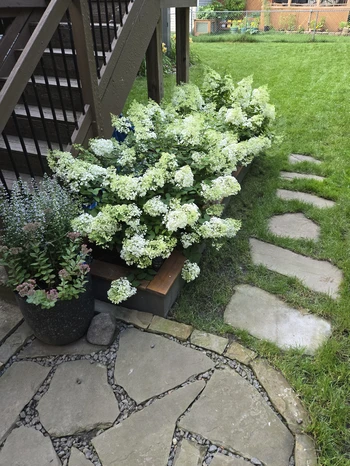
If you’ve made it to the end, thank you so much for spending the time to read my post. Hopefully I was able to provide you with enough to think about to help you decide if adding raised beds into your landscape is the right choice for you.

